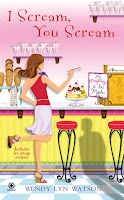My writing process? Strangely enough, it’s not based on the written word.
I see and hear the scenes in my head. Then I type them into the computer.
Although I’ve been a voracious reader since grade school, I didn’t try to write fiction until about six or seven years ago. My first short story was written on a computer in my living room while I listened to CNN. I wrote it while drinking Pepsi One and eating Strawberry Twizzlers.
So my writing process?
Want to guess? In order to write I have to be sitting at my computer in my living room with CNN on the tv, a can of Pepsi One next to me, and okay, well – the Twizzlers are optional. I’m not completely nuts!
Seriously, I can’t write fiction using paper and pen. I’ve tried. A sentence or two is all I can squeeze out the old fashioned way.
I’m a fast typist and using a keyboard helps me get my thoughts down before they slither off. I’m composing this blog at my computer. I’ve changed the first line of this paragraph four times – trying to decide if “slither off” is the right phrase. (My co-author, Marian, wouldn’t care for me ending a sentence with the word “off,” but I’ll worry about that later.) As you can see, “slither off” won out over “escaped.”
Okay, so computer, Pepsi One, CNN, and Marian are needed in order for me to write – not necessarily in that order. I mentioned Marian before, right? She gets the credit, uh … blame for getting me into this fiction writing business. Not that I’ve actually met her in person – we are internet friends and writing partners. One day she typed, “We should write a book together.” I typed back, “We should think about it.”
I hesitated because I was afraid of failing. It’s easy to have the dream of writing a book – I’d guess most people have that dream at some point in their life. Having the dream is nice. It’s comfortable. It’s something to think about when your day job is less than fulfilling. But actually doing something about achieving that dream is scary. If you try and fail, then what? That dream is isn’t so golden any more.
But I’d been tempted, so after a few weeks of consideration, we started. We expanded a short story we’d written about a private detective and his Irish wolfhound partner. “Evelyn David” was born.
In order for me to write, I have to be in the “right” frame of mind (pun not intended but there it is), with the right tools handy (maybe the word “right” in this phrase is too much?), in order for me to find that fictional world in my head. And for me it’s all about characters.
I usually put two characters in a room, close my eyes and listen for a conversation to start. Two of my favorite characters from the Sullivan Investigations Mystery series are the twenty-something computer wiz JJ and the seventy-something, scooter riding Edgar. The only thing they have in common is their fondness for Mac Sullivan and a desire to become full-fledged detectives.
“How did you like my great nephew?”
“Is the no hair thing hereditary?”
“He’s a Marine.”
“Hooya!”
“He’s single.”
“Thanks for the warning. Mac is getting me a Taser for my birthday.”
The conversation stops. And I consider how I might use the dialogue. Or not. My writing always starts with dialogue, even if it’s inner dialogue. Then I go back and layer in background details and physical action. After I polish up the scene, I e-mail it to Marian.
I’ve tried to outline. I know how to draft an outline. Under great duress I can create an outline and I can write by it. But the process takes all the fun out of writing for me. The voices are muffled. The typing slows. Soon I’m thinking that mopping the kitchen might be a preferable activity.
If you’ve read Marian’s Monday blog, you’re probably wondering how in world we write anything together. She likes to know where we’re going before we get there. Preferably before we start. And I can’t tell her – at least not until we are about 20 pages into the first draft. Then all at once some real plot starts creeping into the scenes. Something clicks. There are choices to be made. Questions to be answered. Why does JJ dislike Edgar’s great nephew? And what’s his name anyway? [Note: find name that is different from any other characters – and for goodness sakes no more Irish names! Ask Marian.] Is the great nephew really a Marine? Is Edgar’s disappearance related to his relative’s visit? Do we want Edgar to have a major plot line in this book? Where did Carrie and Ray go? This was supposed to be their time to shine and they’re awol!
At that point in the process Marian and I start to figure out what the A and maybe B plot lines will be. We sift through the ideas – decide which ones make the most sense. We decide which characters we’re going to use in this particular book. A very loose outline is developed. We keep writing, alternating scenes, editing as we go. We watch for the C plot line to appear – a minor storyline that develops from an unexpected event or line of dialogue. Once it shows up, we deliberately expand on it and weave it throughout the book.
Sometimes after that initial twenty pages we have to start over – sometimes we just have to rewrite a few scenes. The opening scene always gets rewritten multiple times. But the main thing for me is to start. Not talk about starting, but start.
That’s my writing process.
Rhonda
aka The Southern Half of Evelyn David
http://www.evelyndavid.com/




